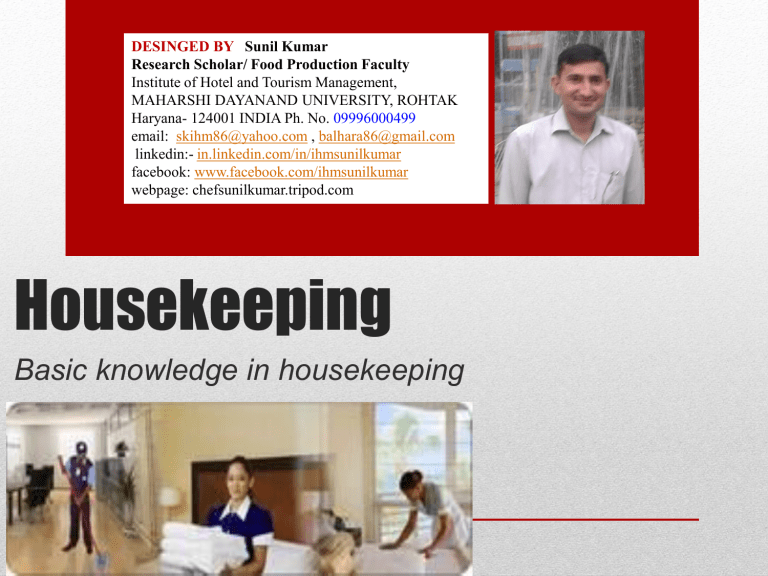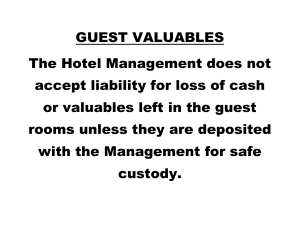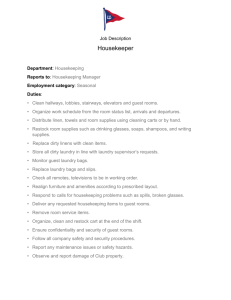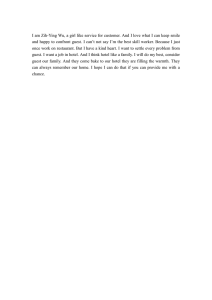
DESINGED BY Sunil Kumar Research Scholar/ Food Production Faculty Institute of Hotel and Tourism Management, MAHARSHI DAYANAND UNIVERSITY, ROHTAK Haryana- 124001 INDIA Ph. No. 09996000499 email: skihm86@yahoo.com , balhara86@gmail.com linkedin:- in.linkedin.com/in/ihmsunilkumar facebook: www.facebook.com/ihmsunilkumar webpage: chefsunilkumar.tripod.com Housekeeping Basic knowledge in housekeeping Importance of housekeeping • The hotel’s main product. • In order to be competitive in the industry, they must have a clean and functional room. • An image of a clean room creates an imagery of impeccable service. Housekeeping Department • Get help when lifting heavy items. • Follow these safe lifting methods: • Bend your legs , not your back, when you pick up something heavy. • Hold the heavy item close to your body. • Move to face the heavy object before you lift instead of twisting your body. Your Safety: Lifting heavy objects • Use a cart to move linens, laundry, or other heavy items. • Push rather then pull carts. • Take regular rest breaks, even just short breaks to stretch your body. • Take turns with other workers to do different types of tasks. • Pad your knees (with a mat or towel) and change your position often when you work on your knees. Doing the same motion over and over • • • • • • • Clean up spills immediately. Keep floors dry. Never run or move too fast. Do not carry items too tall for you to see over. Wear shoes with non-skid soles. Use a ladder or footstool to reach objects up high. Never stand on the edge of a bathtub, bed, or chair. Slippery and cluttered floors Laundry and other cleaning products • Ask for information about the chemicals you use. • Read labels and follow instructions before using. • If you do not understand the label, write down the name and ask someone for help. • Wear goggles and gloves when needed. Your boss should provide them. • Do not mix chemicals together. • If you are being yelled at or harassed by anyone, get help from a co-worker or your boss. • If someone continues to harass you at work, get help from a trusted friend or community organization outside the workplace. • Do not work alone in a hotel room if hotel guests are present. Handling abusive guest • Wash hands with soap often, especially after handling soiled linen or cleaning the bathroom. • When you handle trash cans or bags, watch out for syringes, razor blades, or other things that might hurt you or spread disease. Diseases from hotel guests • Research on new technologies featured on rooms • Provide pictures on your favorite hotel guest rooms. Explain why it is your ideal room and provide a short description on the features of the room. • Why is housekeeping an important department in the hotel? • Why do we need to learn the room attendant prerequisites? Study guide • Single Rooms: A room designed for a single traveler. • Double Rooms: A room with two double beds. Doubles beds size is usually 54 × 75 in (4’6″ × 6’3″) or 137 × 191 cm. • Twin Rooms: A room with two single beds. Single bed size is usually 39 × 75 in (3’3" × 6’3″) or 97 × 191 cm • Suite Rooms: A complete room usually with a foyer that connects to one or more bedrooms. Usually, these are the most expensive rooms in the hotel Types of guest rooms • Earliest Beds Our earliest ancestors simply slept on the ground. • Egyptian Beds Piled palm leaves in their houses and slept on them, while the pharaohs slept on flat pallets made of hard materials such as gold. • Roman Beds The Romans invented the mattress, making beds that were comfortable as well as decorative. History of Beds • Renaissance Beds Roughly 1400 to 1600, beds were located in every room of the house, doubling as couches during the day. • Mattress History Renaissance mattresses were filled with straw and bound with rope. Only in the late 1700s were softer cotton mattresses introduced. • Modern Beds The 20th century saw the evolution of comfortable mattresses, including foam mattresses, waterbeds and the queen-size mattress. History of Beds Bed Type US Size European Size Single 39 × 75 in (97 × 191 cm) 35 × 79 in (90 × 200 cm) Double 54 × 75 in (137 × 191 cm) 55 × 79 in (140 × 200 cm) Queen 60 × 80 in (152 × 203 cm) 63 × 79 in (160 × 200 cm) King 76 × 80 in (193 × 203 cm) 71 × 79 in (180 × 200 cm) Guestroom beds Brief Description Hotel Cycle Department Head Section Manager Supervisory Rank and File Task to clean and maintain the quality of guest room. These are comprised mostly of chambermaids and room attendants. In some establishments, the minibar team is usually under this department (depending on the size of the property). Typically, in-stay, departure and post departure phase Executive Housekeeper Guest Room Supervisor Room Attendants Chambermaids Minibar Attendant · In some of the hotels Room Service attendant is part of rooms This department handles all laundry, dry cleaning and pressing needs of the hotel and guest. Cleans and maintains all public areas of the hotel. Commercial needs of the hotel are performed in all phases. Guest laundry is mainly performed during in-stay process of the laundry. Director of Rooms Executive Housekeeper/Laundry Manager Laundry Supervisor Laundry Attendants Linen Attendant Steam Pressure/Ironer Valet Runner Performed in all phases. Lobby cleaning is usually performed during night time, as there is lesser traffic in the hotel during these hours. Executive Housekeeper Public Area Supervisor Utility man Public Area Attendants Pest Control Gardener Housekeeping Organizational Chart • Room Cleaning • Laundry services: • Commercial laundry (uniforms, linens, towels, table napkins, table cloths and others) • Guest laundry (laundry of guest) • Minibar • Public areas • Location and facilities of the hotel where the public can generally use. These include the lobby, public sitting areas, public toilets and walkways. Housekeeping activities •Early make up request is the request of the guest to “make up room” of the guest. •VIP rooms are guestrooms that require extra attention since the occupants are considered Very Important Persons. •Blocked rooms are guestrooms that are reserved for guest with special requirements or needs. •Vacant and dirty rooms are checked out rooms to be blocked by front office for prospective guest. Room Assignment Priority • Late Checkout rooms are guestrooms are request made by the occupant and subsequently granted extension of check-out beyond the standard checkout time. • DND (Do not disturb) as per request of guest(signage), rooms are not to be cleaned until specific request of guest. • No service rooms are guestrooms requested by guest that his room not be cleaned. Room Assignment Priority • • • • What are the different types of guestrooms? Discuss the history of Bed What are the different sizes of bed? Select one job in housekeeping and research on his competencies • What are the different room assignment priorities? Why do we need to know this as future room attendants? • What are the different housekeeping activities? Study guide Toilet bowl cleaner stains, rust and others from bowls and urinals. • A toilet Bowl cleaner kills germs and get out hard • An effective toilet bowl water deposits such as cleaner kills a wide range bowl ring in the toilet bowl. of disease-and odorcausing bacteria. There • Most toilet bowl cleaners are commercial cleaners may contain hydrochloric readily available in stores. or phosphoric acids. For larger hotels, These acids aids in distributors and suppliers removing all kinds of dirt, sell industrial cleaners. Chemicals All purpose cleaner • • An all purpose cleaner concentrated generalpurpose cleaner should be gentle on the hands and be tolerable for any furniture surface. A good number of all purpose cleaners have a PH level of 11 to 12. Chemicals Most of the all-purpose cleaners nowadays are equipped will germ killing formulation. Glass cleaner • The cleaner is usually • A glass cleaner is meant partnered with the squeegee for fast and for windows, mirrors, effective cleaning of glass counters, tabletops, display cases windows. and other glass Wood polisher surfaces. Some contain • Use polish only if the ammonia solution and furniture starts to look alcohol content to clear dull, worn-out and seedy. away grease, dirt and fast dry. Chemicals Chrome & brass polisher • Metal polishes contain solvents and detergents to remove tarnishes, mild abrasives and oil to brighten and slow down the tarnish process in metals. Chemicals 1. 2. 3. 4. 5. Chamois and non-abrasive sponge Chamois absorbs liquid up to seven times their weight. It is 6. used for drying various surfaces such as granite, marble, mirror and glassware. Toilet brush, Toilet swab, bucket, scoop Toilet brush is a bristle brush often uses to clean inside the toilet bowl. Toilet swab or Johnny mop is a ball of rayon, acrylic or cotton at the end of long handle. The tool is designed to clean the bowl without scratching its surface. Complete set of rags: 1. 2. 3. 4. 5. 6. Cleaning Tools One (1) for toilet One (1) for dusting wooden surfaces One (1) for drying marbles Two (2) for glass and mirrors Squeegee Tool designed to swipe dry glass and windows. • Basic room amenities are stocked in their housekeeping cart for replenishment of used items. • Room amenities would include linens, towels, room forms, stationary, pencils, bath toiletries and others • Room amenities would vary from one property to another. • Amenities in the hotel room are based also on the number of occupants. For example, if there are two people in the room bathroom supplies and amenities should be adequate for two people. Room amenities Enter guest room Prepare Room for Cleaning Clean room area Dust the room Make the bed Clean the bathroom Replenish supplies and guestroom amenities Vacuum Guestroom area Exit Guest Room Room Cleaning process 1. Rooms are accessed according to the property’s standards Entering a guestroom is the first contact with guest. If done professionally, this will leave a lasting impression with the guest. 2. Find out if the guest is in the room. •If a Do Not Disturb (DND) sign is displayed at the door, note it on your worksheet and return to the room later. •Ask your supervisor to call the guest if DND sign is still displayed on the door. Entering guest room 3. Properly introduce yourself in entering the room. • Knock the door announcing “Housekeeping” and step back for about three feet from the main door so that the guests can see you from the door eye viewer. • If there is no reply from the room, after 10 seconds knock for the second time announcing “Housekeeping”. • After the third attempted knocking the door, simultaneously use your master key and announcing “Housekeeping” in opening the room. When you are reasonably sure that there is no occupant, open the door wide. Entering guest room 4. If the guest is inside the room ask permission if you can clean the room. • Introduce yourself and politely ask if you can clean the room. • “Good morning/ afternoon/evening (guest name). Is it alright if I can clean your room?” • If the guest gives a later time, note the time on your room assignment sheet. Thank the guest, and quietly leave the room and return on the specified time given by the guest • Sometimes the guest will be sleeping or in the bathroom. If so leave quietly, close the door and return on later to clean the room. Entering guest room 5. Prop open the guest room door • Use doorstopper • Time and motion from going to the housekeeping cart 6. Position your cart • Blocks the room from possible intruders Entering guest room



